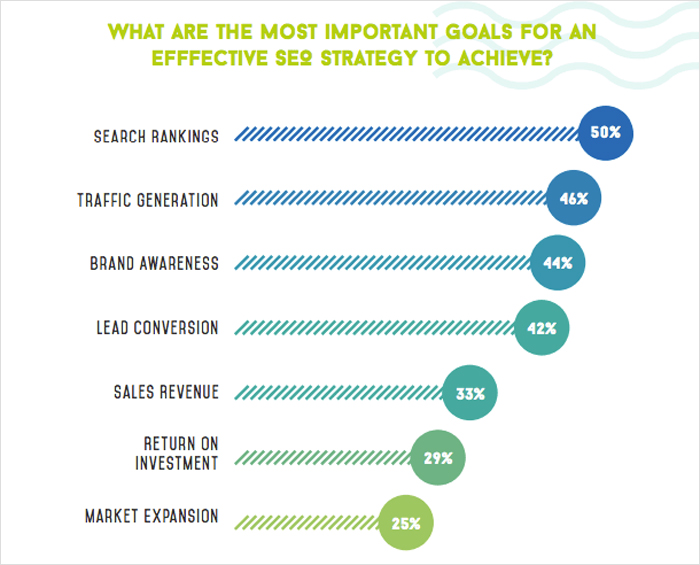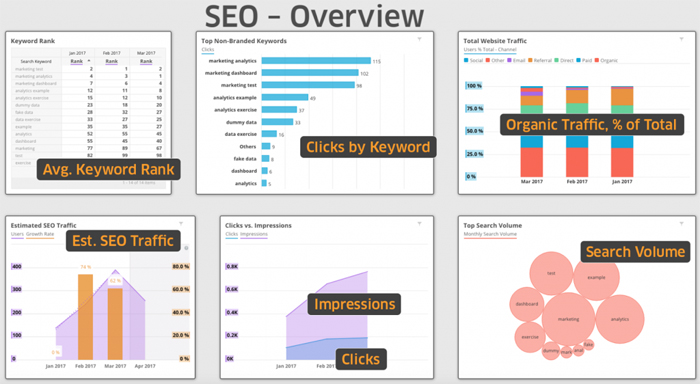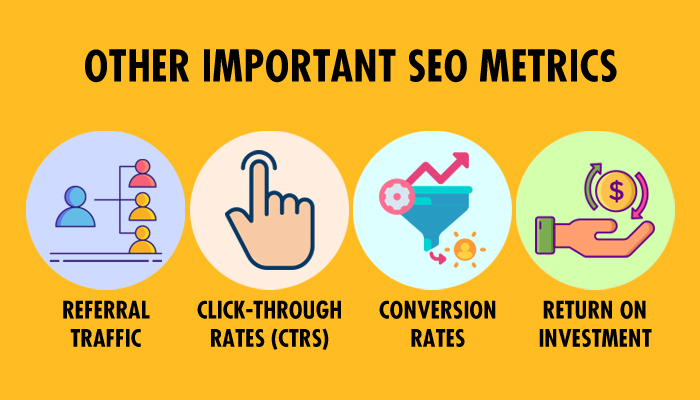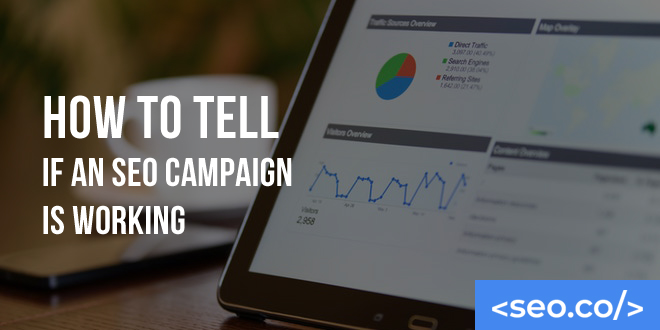Search engine optimization (SEO) is a complex strategy, and one where there’s rarely a single “right” answer to any question. Your rankings are a the result of hundreds, if not thousands of interacting factors, and Google doesn’t disclose how—exactly—its algorithm works (though we have some good guesses based on its algorithm update history).
Measuring the results of your SEO campaign can also be challenging, especially for newcomers to the online marketing field. How are you supposed to determine whether your SEO campaign is actually working? And what do you do if it isn’t?
Table of Contents
Defining Your SEO Goals

Source: SmartInsights
Before we get into how to tell if an SEO campaign is working, it’s important to define what “working” means for you. SEO serves many purposes for your organization; ranking higher can increase your brand visibility and your incoming traffic. But are you more worried about the sheer number of visitors you’re getting, or which pages are ranked number one? Is it better for your company to have 100 visitors with a 5 percent conversion rate or 200 visitors with a 2.5 percent conversion rate? There aren’t objective right answers to these questions—only what’s right for your brand.
You should also consider the peripheral effects that SEO can have. For example, most companies that pursue SEO invest heavily in their onsite content strategy, which can improve their brand reputation and help secure more conversions. How do these peripheral benefits factor into your judgement of your SEO strategy’s success?
We’ll get into the most important key performance indicators (KPIs) in the next couple of sections, but before that, take some time to clarify what your SEO goals truly are.
Typical KPIs for SEO: Is Your SEO Campaign Working?

Let’s say you’ve been working on an SEO campaign for a few weeks now, and you’re interested to see if your efforts are making a difference. You’ve been producing onsite content, you’ve got your website’s technical SEO factors in order, and you’ve been building backlinks just as all the experts suggested.
What now?
There are a handful of key performance indicators (KPIs) that stand out as hallmarks of an effective SEO campaign overall:
- Rankings. This is the most obvious factor, and the one most SEO newcomers gravitate toward, but it isn’t the be-all end-all measure of success for your campaign. “Rankings” are how the various pages of your site rank for your target keywords and phrases; typically, you’ll keep a list of all the words and phrases you’re actively targeting, and will use a tool like SEMRush to determine where you’re ranking (and where your competitors are ranking). Obviously, upward trajectory here is a good sign; if you’re ranking higher for all your targets, month after month, it means you’re making forward progress, and your tactics are making an impact. However, these expectations should be tempered; some keywords are incredibly easy to rank for, allowing you to skyrocket to the number one position, without giving you much traffic or being especially relevant to your brand. The reverse is also true; you may spend a ton of effort increasing your rank only slightly for a highly competitive keyword, seeing only marginal bottom-line benefits from your efforts.
- Organic traffic. Rankings are perhaps best held in consideration in the context of organic traffic, or the number of people who visit your site after discovering it in search engines. In some ways, this is the truer indicator of SEO success; regardless of how many keyword terms you’re ranking for, or how high in the rankings you climb, this number could be high or low depending on factors like click-through rates (CTRs), search volume, and your competition. You can find your organic traffic figures in Google Analytics, and tinker with the settings to see your traffic both for your entire domain and for individual pages of your site.
- Domain and page authority. Google measures the trustworthiness of your site and its individual pages based on the quantity and quality of links pointing to them, eventually resulting in an “authority” score. The higher your domain authority, the easier it will be for all the pages of your site to rank. The higher your individual page’s authority, the more likely that page is to rank. Accordingly, you could use domain authority as an indicator of your campaign progress; a domain authority that’s growing is a sign you’re doing things right and a foundation on which you can create pages that rank more easily. There are a few ways to discover your domain and page-level authority, including through Moz’s Link Explorer.
Other Important SEO Metrics

There are a few other SEO-related metrics that warrant your attention, though they aren’t as direct an indicator of your progress as the aforementioned KPIs.
- Referral traffic. Also discoverable in Google Analytics, if you’re big into link building, you’ll want to look at referral traffic. Referral traffic is a measure of how many people are visiting your pages from the links you’ve built. This metric doesn’t affect your search engine rankings, nor is it a byproduct of them, but it is a byproduct of one of the most important elements of your SEO strategy: your backlinks. Rising referral traffic is an indication that you’re getting published in bigger and more important publishers, and that you’re earning more authority for your work. Referral traffic is also a secondary way SEO provides value to your brand, since these visitors are as likely to convert as your organic traffic.
- Click-through rates (CTRs). What happens if you’re ranking at number one for your most heavily favored keyword phrase, yet nobody’s visiting your site? This scenario is unlikely, but you might be getting less traffic from your rankings than you expect if your click-through rates (CTRs) are low. CTRs have a complex relationship with SEO, affecting it and being affected by it, but you can definitely improve your CTRs (and therefore improve the value of each search ranking) by tweaking your title tags and meta descriptions to better appeal to your target audience.
- Onsite behavior and conversion rates. Even with tons of organic traffic, the value of your SEO strategy still depends on your ability to convert that traffic. Spend time studying how your incoming organic visitors behave on your site. Do they spend minutes on your best content pages, reading it and engaging with it? Or do they bounce almost immediately? Better onsite behavioral metrics, like lower bounce rates, may have a marginal effect on your search rankings, but more importantly, they impact the net value of each incoming visitor. If you neglect these factors, even thousands of organic visitors may not be enough to make your search optimization efforts “worth it.”
- Overall return on investment (ROI). Adding to that, for most businesses, the true measure of an SEO campaign’s success is your return on investment, or ROI. That’s because all the nice-looking numbers in the world (like high rankings and organic traffic) won’t mean much if you’re spending more money than you’re seeing from your core tactics. If you’re earning more in new sales than you’re spending on all your tactics, and that gap keeps positively widening, you’ll be in a good place. Use your conversion rates in combination with your organic and referral traffic to estimate how much value you’re getting, and compare that to your expenses. Expenses are easy to calculate if you’re outsourcing your work to an agency, but you may have to get creative if you’re working with an internal team.
Why SEO Takes Time (and Why Not to Bail Out Too Early)
There’s one important caveat to all these considerations. Up until now, we’ve been covering key metrics and indicators that your SEO campaign is working; if they’re showing signs of growth, it means your efforts are worthwhile. However, SEO is a campaign that necessarily takes time, which means you may not see positive results in these areas in the first few months even if you’re doing all the right things. In fact, the majority of campaigns only start seeing the fruits of their labor after 3 to 6 months.
Building authority and developing onsite content often takes months, and you’ll have to wait for Google’s index to fully catch up to you as well. More importantly, the rewards of an SEO strategy in its developed stages are much richer than the rewards in its developing stages; at a higher level of authority, all your links and pages will generate more traffic, and you’ll get more value for even trivial efforts, like writing a new offsite post (assuming you’re doing everything correctly). If you’re not growing quickly, do analyze and critique your own efforts, but don’t panic; if you bail out of your campaign too early, you’ll miss out on the best benefits.
The Ongoing Process
Don’t be discouraged if you find that your SEO campaign isn’t working, or isn’t working the way you thought it would; in fact, this is to be expected. SEO is both an art and a science; the most successful practitioners aren’t able to launch a perfect campaign from day one, but instead are the ones able to recognize flaws and make corrections where necessary. Diagnose your campaign early and consistently, at least once a month, and make adjustments so you’re always moving in the right direction.
Are you unsure how your SEO campaign is faring? Are your KPIs lower than you expected them to be? We can help. Contact SEO.co today for a free consultation of your current campaign, and a plan for how you can start seeing better results.
- Are .gov and .edu Backlinks Valuable for SEO in 2025? - February 3, 2025
- What are the Market Size & Growth Prospects of the SEO Industry? - December 17, 2024
- Marketing Funnels: How They Work and How to Optimize for Maximum Revenue - May 22, 2024



